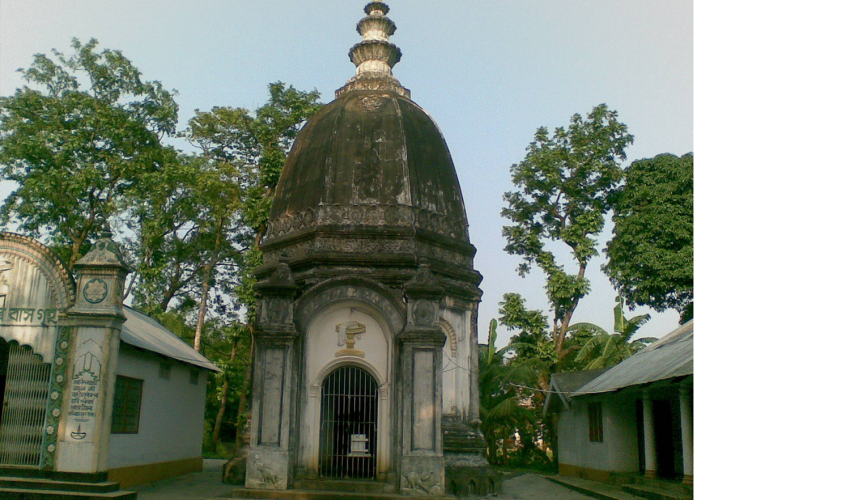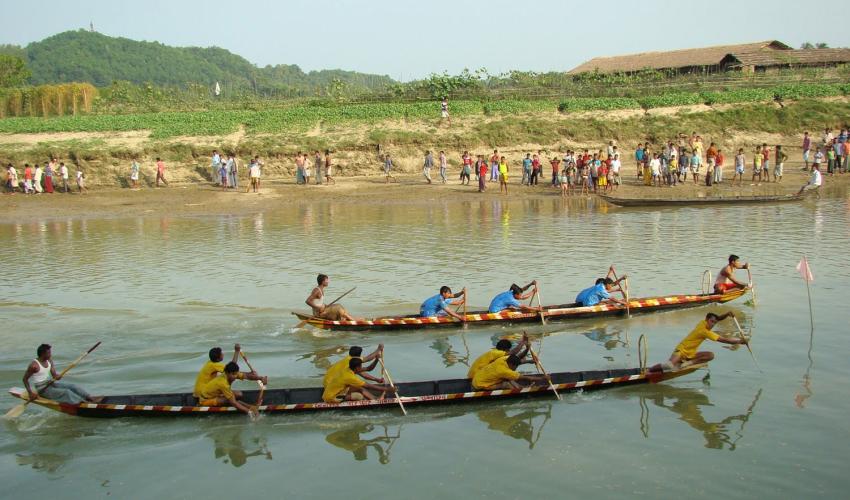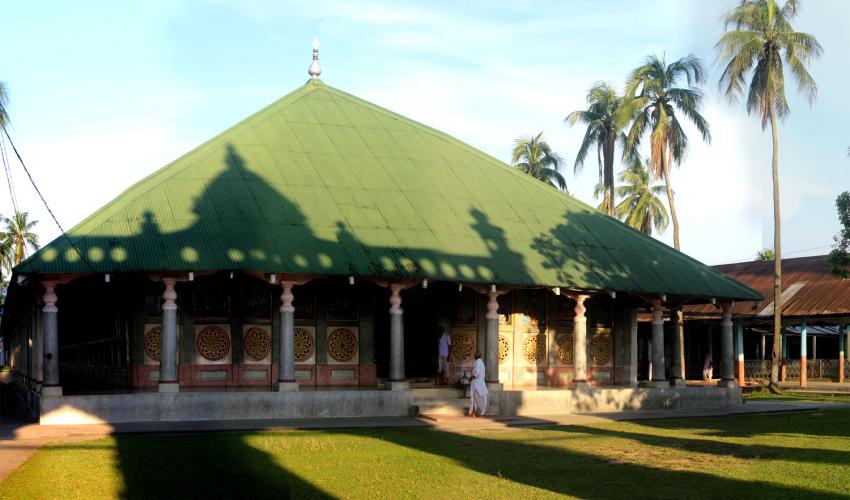Popularly known as the “Land of Satras”, Barpeta is eminent in the historical map of Assam. These Satras carry the testimony of the great renowned Assamese Reformer, Saint, Scholar and Cultural proponentSrimantaShankardev and his ardent disciple Sri SriMadhabdeva. The Saint arrived from Upper Assam in the 16th century, with an aim, to lay down a strong foundation of Assamese culture and heritage in and around the region through his socio-religious Vaishnava-reform movement. This reform movement left a remarkable legacy.Devotees from all corners of Assam pay visit to the famous BarpetaSatra and other Satras spread across the district.
Here is the list of some major tourist attractions in Barpeta:
BARPETA SATRA
Situated in the heart of the city, BarpetaSatra allures tourists and devotees from all across the State especially during Holi (Doul) festival and anniversaries of various Vaishanva Gurus. The KirtanGhar (prayer hall) of this Satra is recognised as the largest in Assam. The building structures within the Satra premises are architectural accomplishments of its own kind. The Three Guru Asanas are placed in this building in homage of SrimantaShankardev, Sri Madhavdeva and Sri Badula Ata. The two Satradhikars sit behind the Guru Asanas to hold NaamPrasanga (singing of hymns) regularly. The Satra is surrounded by numerous buildings within its premises, covering an area of 20 bighas.
CHINPARA VITHI
Located about 1/2kms north of BarpetaSatra, ChinparaVithi is the place where SrimantaShankardeva arrived from his boat at Barpeta on the banks of PalangdiBori, which is now called Palangdihati. The Saint resided here for six months to propagate his Faith on Vaishnavism. The Naamghar set by the Guru still exists.
SUNDARIYA SATRA
SundariyaSatra played a significant role in spreading Vaishnavism and reformation. Situated near the Barpeta town, Sri Madhabdeva founded this Satra and composed the ‘Bhakti Ratnakar’ and ‘Naamghosa’ here in the Vithi of the Satra. The great Saint dug a well here during his brief travel. This well can be seen today also and the water of the well is considered to be Holy. Three Guru Asanas are placed in memory of Sri Shankardev, Sri Madhabdeva and Sri Badula Ata.
PATBAUSHI SATRA
This Satra is a major attraction among devotees and tourists as it was a cultural hub from where Satriya culture art-forms and literature dispersed far and wide. Situated 2kms north of Barpeta town, Saints like SrimantaShankardev, Sri Madhavdev, Sri Damodardev and Sri Haridev stayed in this Satra for propagation of the Vaishnava Faith. SrimantShankardev resided here for 18years and composed 240 Bargeets (hymns), Shastra (socio-religious and cultural texts and literature) and Ankiya Nat (dramas). The scripts are safeguarded here. In present times, the government has taken steps for the preservation of this treasures of Assamese heritage and are working towards setting up of SrimantaShankardev Museum within the Satra premises. The DamodardevSatra is also situated in the same complex.
GANAKKUCHI SATRA
Situated within the range of Barpeta Municipality, GanakkuchiSatra was founded by Sri Madhabdeva, the renowned reformer, who stayed here for more than 18years. The Vithis of Sri Ram Ata and Sri Ram Atoi, are well preserved here along with a number of SachipatPuthis composed by SrimantaShankardeva.
BARADI SATRA
This Satra was founded by Sri Madhabdev. The common people were greatly motivated by the teachings of this great scholar. BaradiSatra served as an important centre for learning.
PARI HARESWAR DEVALAYA, DUBI
This Shiva Temple, situated at Dubi near Pathshala of Bajali Sub-Division, was founded back in the ancient period. Records state that the Ahom King Shiva Singha made land grants measuring about 760 Puras issued in Copper-Plate inscription and contributed an image of Goddess Durga. The legend has it that Queen Fuleswari, wife of Shiva Singha, was influential in bringing ‘Devadasis’ or ‘Temple Dancers’ from Upper Assam to perform dances for amusement of the Deities of this Temple. The well-known dance form ‘Devadasi Nritya’ is said to have originated in this temple.
DARGAH OF SYED SHAHNUR DEWAN, BHELLA
A follower of Muslim Sufi-Saint Ajan Fakir of Upper Assam, Syed Shahnur Dewan arrived and resided at Bhella region to spread the teaching of Sufi Philosophy of Islamic Brotherhood, back in the medieval period. This mystic is said to have spiritual healing power. On curing a maternity problem of Queen Fuleswari, wife of Ahom King Shiva Singha, the King issued land grants and other patronages to the Fakir. Ahom King Chandra KantaSingha also presented land recorded in Copper-Plate inscriptions, which had been lost during the Burmese invasions of 1824.
GOROKHIA GOSAIR THAN, NIZ SARIHA (SORBHOG)
Sri Narayan Das Thakur Ata, a follower of the Saint SrimantaShankardev, came to offer his devotion that was said to be founded by some cow herd (Gorokhia). The building structure of this Than has a similar semblance of the KirtanGhar of BarpetaSatra, This Than is spread over an area of 25 Bighas where ‘Doul’ festival is celebrated annually with great pomp and grandeur.
MANAS NATIONAL PARK
Situated at the foothills of the Himalayas, Manas National Park is known for its rich bio-diversity and breath-taking landscape with the River Manas flowing through the National Park. Famous for some of the most endangered species like the Golden Langur, Pygmy Hog, Hispid Hare, it is home to different varieties of wild life. It has been recognised, as a Project Tiger Reserve, an Elephant Reserve and a Biosphere Reserve because the park is habitat to a large number of tigers, elephants and diverse fauna species. The Manas National Park has been declared as Natural World Heritage Site by the UNESCO. A must-visit, for travellers who wish to explore the serenity and tranquillity amidst the spectacular beauty of the landscapes and the calm waters of the Manas river, it presents a remarkable wilderness experience. Forest lodges are located inside the Park at Mathanguri which is 40kms from Barpeta road.
BRASS METAL INDUSTRY OF SARTHEBARI
Known for the household Brass Metal Industry, Sarthebari town is situated in the easternmost corner of the Barpeta district. Large number of households get involved in this industry whichdevelops skills in making Sarais, Bota, Ban-Batis, Thals, Glasses etc. that are traditionally used by the Assamese people. These utensils are significant and serve as a unique contribution towards Assamese tradition and culture . Due to increasing cost of required raw materials which get imported from other states, the artisans are having a hard time economically to continue the industry.
HOW TO REACH BARPETA
The nearest airport is the Guwahati Airport. The nearest railway station is Barpeta Road which lies at a distance of 21kms from Barpeta town. Barpeta town is connected to NH-31 through Howly, and Hajo-Doulashal road connects it to Guwahati town. Regular bus services are available between Barpeta and Guwahati.
Barpeta
Assam



